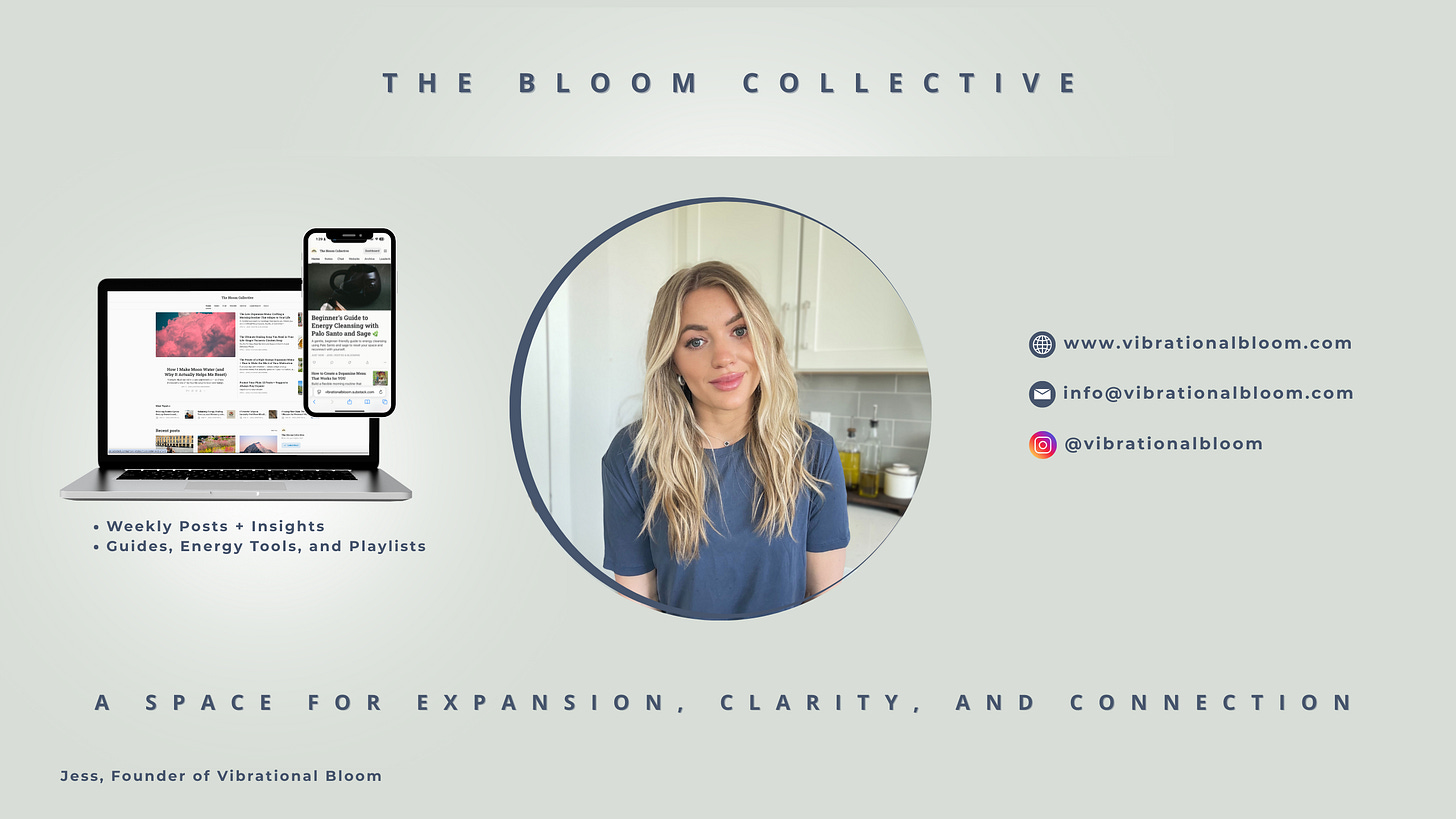Nervous System Reset: How Breathwork Supports Calm, Clarity, and Resilience
Breathwork basics for when you’re overstimulated, burned out, or just need a soft reset.
TL;DR: ⚡️
Burnout isn’t always dramatic. Sometimes it shows up as brain fog, missed texts, and feeling “meh” about things you usually love. In this post, I’m sharing how breathwork helps regulate my nervous system, the early signs I watch for, and small ways I find my way back through simple breathing practices and soft resets.
Before we dive in... I wanted to open this up to those of you tuning in 🕊️ I’m now offering 1:1 Reiki sessions, both virtually and in person. If you’ve been feeling a little off, stretched thin, or just craving a quiet space to land, these sessions are here to support you.
To book, email info@vibrationalbloom.com, visit vibrationalbloom.com, or send me a DM.
By Jess / The Bloom Collective
Some mornings feel gentle and clear. Others feel like wading through molasses. Burnout doesn’t always come in loud. Sometimes it drifts in slowly — missed texts, brain fog, and the quiet hum of disconnection.
In my last post, What Burnout Really Feels Like, I talked about how burnout often hides in plain sight. Today, I want to share one of the most effective tools I return to again and again: breathwork.
This isn’t about fancy techniques or perfection. It’s about creating safety in your body. When you feel off, breathwork gives you something immediate, accessible, and empowering.
Why Breathwork Matters for the Nervous System
Your breath is the fastest way to communicate with your nervous system. Slow, intentional breathing activates the parasympathetic nervous system (your body’s rest and digest state) through the vagus nerve. This helps:
Lower heart rate and blood pressure
Reduce cortisol (stress hormone)
Improve emotional regulation
Increase heart rate variability (HRV), a sign of resilience
Research-Backed Benefits 📚
Breathwork isn’t just calming. It’s clinically powerful.
A 2023 Stanford study found just 5 minutes of daily breathwork (especially emphasizing long exhalations) improved mood and reduced anxiety more effectively than meditation.
Alternate nostril breathing (Nadi Shodhana) reduced resting heart rate and perceived stress after just a few weeks of practice.
Box breathing (inhale 4, hold 4, exhale 4, hold 4) increased vagal tone and helped participants bounce back faster from stress.
Real-Life Moments: Breathwork in Practice
Inside the Vibrational Bloom community, I’ve seen this firsthand:
"Box breathing saved me during a panic spiral at work—I just sat still, breathed in 4s, and felt my pulse actually slow."
"Alternate nostril breathing before bed helps me fall asleep faster and stay asleep longer."
Personally, I use breathwork:
Before calls when I feel anxious
After a triggering text or conversation
During cold exposure (more on that in the next post!)
I even build it into my walks: inhale for 4 steps, exhale for 6. It turns a normal walk with Bagel into a nervous system tune-up.
A Few Simple Techniques to Try
Box Breathing
Inhale 4, hold 4, exhale 4, hold 4. Repeat for 1–3 minutes.
Extended Exhale
Inhale 4, exhale 6 or 8. Great for winding down.
Alternate Nostril Breathing
Use thumb and ring finger to gently close one nostril at a time. Inhale left, exhale right, then reverse.
Do it for even 60 seconds. Notice how your body responds.
Breath Is Power, Not a Performance
You don’t have to get it perfect. You just have to remember that your breath is always with you. It’s a built-in reset button.
I unpack this more in The Dopamine Menu—a guide to building mornings that feel like support, not stress.
Whether you’re recovering from burnout or just feeling off, breathwork can help you come home to yourself—one inhale, one exhale at a time.
Let’s Stay Connected
New posts go live every Thursday at 6 PM MST. Tune in each week for fresh reflections and routines to support your energy and clarity.
🛍️ Etsy: Vibrational Bloom Shop
🌐 Website: www.vibrationalbloom.com
📸 Instagram: @vibrationalbloom
🎥 TikTok: @vibrationalbloom
Follow along for insights, slow living tools, and ways to feel more like yourself in the days ahead.
With warmth and light,
Jess 🌿
Reiki Healer, Modern Wellness Writer & Founder of Vibrational Bloom
Sources
Stanford Breathwork Study (2023)
Balban, M. Y., Irwin, M. R., Craske, M. G., & Huberman, A. D. (2023). Brief structured respiration practices enhance mood and reduce physiological arousal. Cell Reports Medicine, 4(1), 100895.
https://doi.org/10.1016/j.xcrm.2022.100895Alternate Nostril Breathing and Stress
Telles, S., & Naveen, K. V. (2008). Alternate nostril yoga breathing reduces blood pressure and increases performance in a vigilance task. Indian Journal of Physiology and Pharmacology, 52(2), 197–200.
PubMed link: https://pubmed.ncbi.nlm.nih.gov/28149027/Box Breathing and Vagal Tone
While not tied to one academic study, box breathing is widely supported in clinical and military settings. It is endorsed by sources like the Cleveland Clinic for stress management and vagus nerve stimulation.
https://health.clevelandclinic.org/box-breathingHeart Rate Variability & Resilience
Shaffer, F., & Ginsberg, J. P. (2017). An overview of heart rate variability metrics and norms. Frontiers in Public Health, 5, 258.
https://doi.org/10.3389/fpubh.2017.00258





